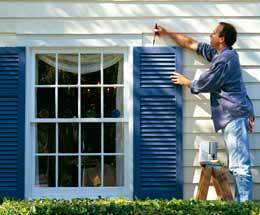
Depending on where you live, spring may have sprung. For some of us in the Midwest, we’re still waiting.
No matter where you live, weather can cause damage to your home. Bonnie Pesch, senior personal lines underwriter shares areas to examine on your home after a long, cold winter.
Windows: In the winter, windows ideally keep the cold air out and the warm air in, and in summer, they should do just the opposite. If your windows don’t do this, you’re probably wasting money on your heating/air conditioning bills.
To make sure your windows are doing their job, check that the caulking and weather stripping are still in good condition. If not, replace them. If there’s condensation on your window, either the glass or the window should be replaced. Faulty windows, as well as window trim that’s not maintained properly, can allow moisture into your home. That moisture can lead to mold and damaged dry wall.
Gutters: Gutters should direct water away from your home and help keep it out of your basement. It’s important, however, that the water NOT be directed over a walkway or driveway. If it freezes, it could create a liability exposure for you if someone slips or falls. Gutters expand and contract, depending on the temperature; they should be flush with the roof and not sag or dip.
Roof: Check for loose, missing, or cracked shingles. Are the shingles curling? What about nail-pops? These issues should be addressed to ensure water doesn’t get into your home. An aging roof can be a concern as shingles lose the ability to shed water as they age. Older shingles are also more prone to hail damage. If your roof is getting old, or you see even a small amount of deterioration, don’t wait too long! Over just one summer, sun exposure can increase the rate of the roof’s deterioration, and then before you know it winter in here. Don’t let that aging roof sit in the snow, ice, and rain, hoping no water gets into your home. What a mess it could be!
Foundations: Be sure to examine the foundation for any cracks that can allow water in. Sometimes just caulking cracks isn’t sufficient. Consider contacting a foundation specialist to assess your home.
Exterior Walls: Do you have water stains on your exterior walls? If so, this may be an indication that your gutters aren’t adequately containing rain water. Perhaps the gutters need to be cleaned or straightened. If you have wood siding, check for holes or openings that can allow ants, woodpeckers, or other critters to nest or burrow through. If the paint on your wood siding is peeling, you should properly scrape and re-paint the wood to protect it from the weather elements.
Chimneys: Mortar deterioration can lead to moisture. Repairing the mortar and replacing deteriorated bricks can be a DIY project, but if you’re not comfortable on the roof, call a professional. Also check the cap and screen to be sure they keep water from entering the flue inside the chimney. You should have your chimney/flue inspected and cleaned every year to make sure there are no cracks, deterioration, or debris blocking the hot air/smoke to escape. During the winter, we see a large number of home fires associated with chimneys.
Decks: You should check your deck periodically to be sure the posts are still solid, the deck boards haven’t rotted, and the railings aren’t wobbly. All of these create a liability exposure on your premises. What if someone would fall down the steps because the post or railing wasn’t maintained properly?
When everything is finished and in good condition, I suggest you plant some beautiful flowers, sit back on the deck, and watch your neighbors figure out what repairs they may need.
Do you have any tips you’d like to share? I’d love to hear them; please share them in the box below.


Discussion
There are no comments yet.